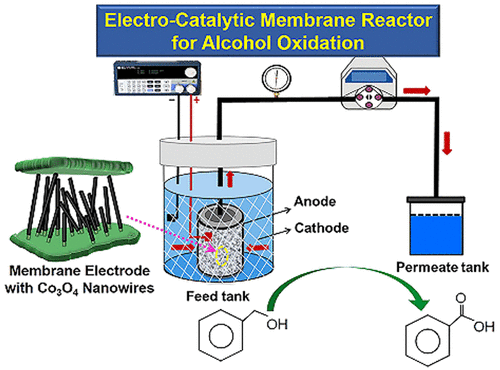Our official English website, www.x-mol.net, welcomes your feedback! (Note: you will need to create a separate account there.)
Engineering Interface with One-Dimensional Co3O4 Nanostructure in Catalytic Membrane Electrode: Toward an Advanced Electrocatalyst for Alcohol Oxidation
ACS Nano ( IF 17.1 ) Pub Date : 2017-11-21 00:00:00 , DOI: 10.1021/acsnano.7b06287 Zhen Yin 1 , Yumei Zheng 1 , Hong Wang 2 , Jianxin Li 2 , Qingjun Zhu 3 , Ye Wang 1 , Na Ma 2 , Gang Hu 4 , Benqiao He 2 , Axel Knop-Gericke 3 , Robert Schlögl 3 , Ding Ma 4
ACS Nano ( IF 17.1 ) Pub Date : 2017-11-21 00:00:00 , DOI: 10.1021/acsnano.7b06287 Zhen Yin 1 , Yumei Zheng 1 , Hong Wang 2 , Jianxin Li 2 , Qingjun Zhu 3 , Ye Wang 1 , Na Ma 2 , Gang Hu 4 , Benqiao He 2 , Axel Knop-Gericke 3 , Robert Schlögl 3 , Ding Ma 4
Affiliation

|
Electrochemical oxidation has attracted vast interest as a promising alternative to traditional chemical processes in fine chemical synthesis owing to its fast and sustainable features. An electrocatalytic membrane reactor (ECMR) with a three-dimensional (3D) electrode has been successfully designed for the selective oxidation of alcohols with high current efficiency to the corresponding acids or ketones. The anode electrode was fabricated by the in situ loading of one-dimensional (1D) Co3O4 nanowires (NWs) on the conductive porous Ti membrane (Co3O4 NWs/Ti) via the combination of a facile hydrothermal synthesis and subsequent thermal treatment. The electrocatalytic oxidation (ECO) results of alcohols exhibited superior catalytic performance with a higher current efficiency on the Co3O4 NWs/Ti membrane compared with those of Co3O4 nanoparticles on the Ti membrane (Co3O4 NPs/Ti). Even under low reaction temperatures such as 0 °C, it still displayed a very high ECO activity for alcohol oxidation in the ECMR. For example, >99% conversion and 92% selectivity toward benzoic acid were obtained for the benzyl alcohol electrooxidation. The electrode is particularly effective for the cyclohexanol oxidation, and a selectivity of >99% to cyclohexanone was achieved at 0 °C, higher than most reported noble-metal catalysts under the aerobic reaction conditions. The extraordinary electrocatalytic performance of the 3D Co3O4 NWs/Ti membrane electrode demonstrates the significant influence of morphology effect and engineering interfaces in membrane electrodes on the electrocatalytic activity and charge transfer process of nanocatalysts. Our results propose that similar membrane electrodes serve as versatile platforms for the applications of 1D nanomaterials, porous electrodes, and ECMRs.
中文翻译:

一维Co 3 O 4纳米结构在膜催化电极中的工程接口:面向醇氧化的高级电催化剂
电化学氧化由于其快速且可持续的特性,作为精细化学合成中的传统化学工艺的有前途替代品引起了广泛的兴趣。具有三维(3D)电极的电催化膜反应器(ECMR)已成功设计用于以高电流效率将醇选择性氧化为相应的酸或酮。通过将一维(1D)Co 3 O 4纳米线(NWs)通过导电原位负载在导电多孔Ti膜上(Co 3 O 4 NWs / Ti)制成阳极。简便的水热合成和后续热处理的结合。与Ti膜(Co 3 O 4)上的Co 3 O 4纳米颗粒相比,醇的电催化氧化(ECO)结果在Co 3 O 4 NWs / Ti膜上表现出优异的催化性能和更高的电流效率。NPs / Ti)。即使在较低的反应温度(例如0°C)下,它在ECMR中仍显示出非常高的ECO活性,可用于酒精氧化。例如,对于苄醇电氧化,获得了> 99%的转化率和对苯甲酸的92%的选择性。该电极对环己醇的氧化特别有效,并且在0°C下对环己酮的选择性达到> 99%,高于有氧反应条件下大多数报道的贵金属催化剂。3D Co 3 O 4的非凡的电催化性能NWs / Ti膜电极展示了膜电极的形态效应和工程界面对纳米催化剂的电催化活性和电荷转移过程的重大影响。我们的结果表明,类似的膜电极可作为一维纳米材料,多孔电极和ECMR应用的通用平台。
更新日期:2017-11-21
中文翻译:

一维Co 3 O 4纳米结构在膜催化电极中的工程接口:面向醇氧化的高级电催化剂
电化学氧化由于其快速且可持续的特性,作为精细化学合成中的传统化学工艺的有前途替代品引起了广泛的兴趣。具有三维(3D)电极的电催化膜反应器(ECMR)已成功设计用于以高电流效率将醇选择性氧化为相应的酸或酮。通过将一维(1D)Co 3 O 4纳米线(NWs)通过导电原位负载在导电多孔Ti膜上(Co 3 O 4 NWs / Ti)制成阳极。简便的水热合成和后续热处理的结合。与Ti膜(Co 3 O 4)上的Co 3 O 4纳米颗粒相比,醇的电催化氧化(ECO)结果在Co 3 O 4 NWs / Ti膜上表现出优异的催化性能和更高的电流效率。NPs / Ti)。即使在较低的反应温度(例如0°C)下,它在ECMR中仍显示出非常高的ECO活性,可用于酒精氧化。例如,对于苄醇电氧化,获得了> 99%的转化率和对苯甲酸的92%的选择性。该电极对环己醇的氧化特别有效,并且在0°C下对环己酮的选择性达到> 99%,高于有氧反应条件下大多数报道的贵金属催化剂。3D Co 3 O 4的非凡的电催化性能NWs / Ti膜电极展示了膜电极的形态效应和工程界面对纳米催化剂的电催化活性和电荷转移过程的重大影响。我们的结果表明,类似的膜电极可作为一维纳米材料,多孔电极和ECMR应用的通用平台。

























 京公网安备 11010802027423号
京公网安备 11010802027423号